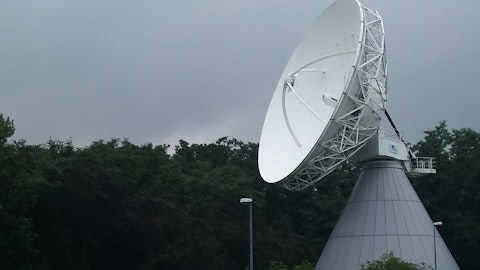Paul Jacobs: So, when you’re talking about the terrestrial spectrum lease, yes, that’s Nokia‘s – we’re doing that through Nokia, so Nokia will be deploying their stuff. Are you talking about the retailer that’s our stuff?
Walter Piecyk: Yes, the Nokia one. Yes, the Nokia one.
Paul Jacobs: Yes, yes, that’s Nokia’s customer. And then on the mission-critical side, yes, we’re not — we haven’t — it is not a bandwidth-constrained environment. So we’re not pushing for massive throughput there is definitely the case where there can be uplink data like video come off the robots and there’s lots of them. So that could end up being a future way that we would expand the system to even provide more capacity. But the key benefit of it is actually the fact that it’s super reliable that there’s no handoff regions that in an environment where it’s in a metal — 3-dimensional metal structure with metal robots and carrying stuff around. So, the RF environment is quite complex and changing all the time. And so our system handles that extremely well, really doesn’t share that much and robots are moving in and out of things like chillers and freezers and some of these metal structures.
That’s where the technology shine a lot. So, we’re not as focused on the spectral efficiency there. Although, like I said, I mean, in the future, as more and more data and telemetry is coming off the robots, then we’ll start to push the throughput even higher.
Walter Piecyk: Got it. And then you talked about this, the network services agreement that you announced today. $20 million minimum fifth year significant upside probably a dumb question but given kind of the allocation of capacity within the constellation, including the new satellites are going up with the first customer, if $20 million, if it ends up being a huge success, $20 million turns into whatever $100 million, is there any incremental CapEx satellites, whatever associated with growing that network services agreement to larger numbers?
Paul Jacobs: No. The way that it’s set up, it can be served from the satellite constellation, the way that we have it with the capacity that we have. So, we’re not pushing the limits on capacity and we’re not pushing the limits on the system and it’s great. It’s a perfect example of how with the bent-pipe architecture and the constellation we have, we can launch new services that are super impactful without having to make big CapEx. So it’s a really nice example.
Walter Piecyk: The 4 pillars of value, wholesale legacy, IoT, terrestrial, 10 years from now, 5 years from now, pick a time, are they equally weighted? Or are you just like, look, one of these may be huge, you just don’t know? Or is there a sense right now having been there a while which is your largest opportunity? Obviously, things can change over the upcoming years. But what are you most optimistic about among those 4 pillars?
Paul Jacobs: I mean I’m pretty excited about — obviously, the terrestrial side is where we came from. So super excited about that opportunity, both on the leasing and the equipment side and services side. But the other — of the existing businesses, the commercial IoT, we’ve seen good growth on. We have ideas of how we can make that better to kind of work our way up the stack, provide solutions. It’s something that we’ve done before. I probably remember, we did a similar kind of path that OmniTRACS where we went from selling bits to selling services and solutions and you can generate significant value that way. So I’m definitely excited about that. And there’s lots of new technologies we can apply to create value there. So I think that’s going to be great.
The company has got a great platform now. The wholesale business has been transformative for the company, created a great platform. And I think we will continue to grow them but like we’ve shown. But I think the one that scales a lot is the one where there’s just so many devices in the IoT business where we can drive solutions business. And then everybody, like I said, the spectrum is super valuable and we’re going to make good value out of that one, too. So those are, I think, the areas that I like a lot. The legacy business, obviously, we’ve been working on that for a long time. It continues to truck along and save people’s lives. We are investing some in it but I would say that’s not the place where I’m the most focused.
Walter Piecyk: Just going back to terrestrial. I might be misremembering this but I think you have the opportunity perhaps to get additional terrestrial rights outside of the U.S. Correct me if I’m wrong but I guess the question though, if that’s true, do these trials — not trials or these initial deployments, I guess, provide an opportunity to convince global regulators to perhaps move that along? Or is that a completely separate process?
Paul Jacobs: I mean that’s a great point that if you can show proof points to why having the terrestrial rights are valuable and will create new economic opportunity, regulators are always interested in that kind of outcome. So yes, I think that’s being able to have proof points is super valuable.
Walter Piecyk: And then, just a last question. The FCC came out some documents about whatever sat to ground. It looks like there’s some exclusion zones as everyone certainly would have expected in terms of using existing cellular spectrum. Just any thoughts you have on at least the original or the initial proposal by the FCC in that market?
Paul Jacobs: On using the terrestrial spectrum?
Walter Piecyk: Using, yes, the cellular license spectrum that Elon and AST [ph] and others would hope to use, I guess?


